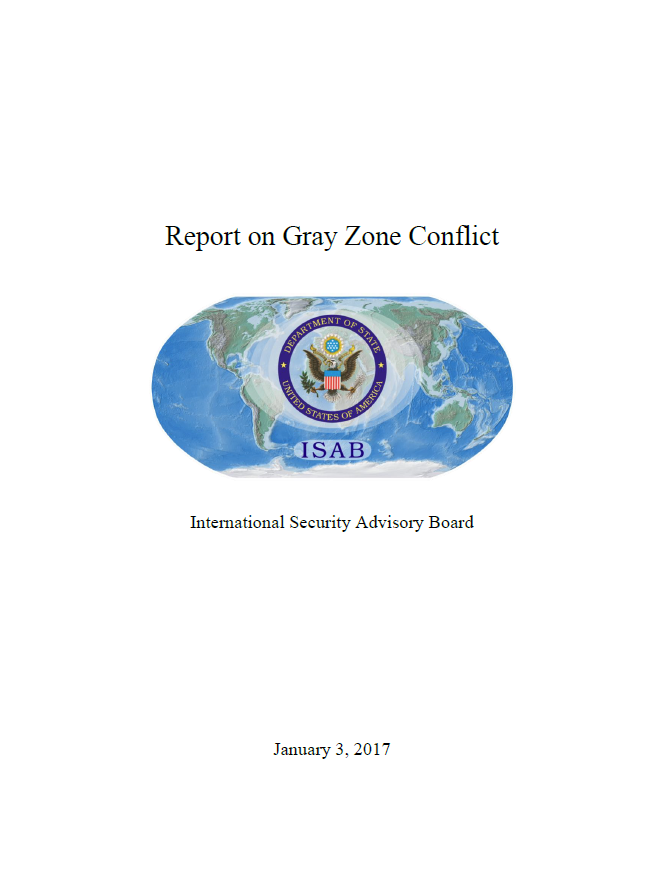The study addresses the challenges facing the United States from the increasing use by rivals and adversaries – state and non-state alike – of what have come to be called “Gray Zone” techniques.
The term Gray Zone (“GZ”) denotes the use of techniques to achieve a nation’s goals and frustrate those of its rivals by employing instruments of power – often asymmetric and ambiguous in character – that are not direct use of acknowledged regular military forces.
The report is organized according to the specific subjects the ISAB was directed to consider by the Terms of Reference (TOR) – Characteristics of GZ Operations, Policy Options and Concepts, and Deterrence/Dissuasion.
I. Characteristics of GZ Conflict
Perhaps the most widely used definition of Gray Zone conflict is that established by the U.S. Special Operations Command (SOCOM): “gray zone challenges are defined as competitive interaction among and within state and non-state actors that fall between the traditional war and peace duality. They are characterized by ambiguity about the nature of the conflict, opacity of the parties involved, or uncertainty about the relevant policy and legal frameworks.” Read too broadly, this definition would embrace practically all international interaction, most of which is directed in some degree at affecting the actions or view of other countries. However, it is possible to describe the problem without seeking a universal and precise definition.
The term “Gray Zone” may be new; the phenomenon is not. Although many of the techniques used now are based on modern technology, notably cyber and networked communication, many are as old as history. What are now being called GZ methods have been conducted in the past under such names as “political warfare,” “covert operations,” “irregular or guerrilla warfare,” “active measures,” and the like. In some sense, the Cold War was one protracted GZ campaign on both sides on a global scale. The Trojan Horse exploited many of the instruments of a GZ operation – creating confusion and division in enemy opinion, extending ostensible inducements, implanting hidden military forces, deception, and clandestine infiltration of enemy territory.
The central characteristic of GZ operations is that they involve the use of instruments beyond normal international interactions yet short of overt military force. They occupy a space between normal diplomacy and commercial competition and open military conflict, and while often employing diplomacy and commercial actions, GZ attacks go beyond the forms of political and social action and military operations with which liberal democracies are familiar, to make deliberate use of instruments of violence, terrorism, and dissembling. Moreover, they often involve asymmetry in magnitude of national interests or capabilities between the adversaries. GZ techniques include:
- Cyber, information operations, efforts to undermine public/allied/local/ regional resistance, and information/propaganda in support of other hybrid instruments;
- Covert operations under state control, espionage, infiltration, and subversion;
- Special Operations Forces (SOF) and other state-controlled armed units, and unacknowledged military personnel;
- Support – logistical, political, and financial – for insurgent and terrorist movements;
- Enlistment of non-governmental actors, including organized criminal groups, terrorists, and extremist political, religious, and ethnic or sectarian organizations;
- Assistance to irregular military and paramilitary forces;
- Economic pressures that go beyond normal economic competition;
- Manipulation and discrediting of democratic institutions, including electoral system and the judiciary;
- Calculated ambiguity, use of /covert/unacknowledged operations, and deception and denial; and
- Explicit or implicit threat use, or threats of use of armed force, terrorism, and abuse of civilian populations and of escalation.
Currently, the United States can reasonably be said to face GZ campaigns in a range of theaters:
- Russia has mounted a variety of GZ operations, not only in Ukraine where it actually employed thinly disguised military force and support for local militias as well as other instruments, but also targeting the Baltics, Eastern Europe, the Balkans, the United States, and a range of European countries with a massive campaign (including expansive use of cyber) to spread its narratives, undermine confidence in legal, economic, and electoral systems, and manipulate political action, exemplified by the FSB/GRU cyber operation that hacked into networks used by U.S. political figures and organizations in what is assessed by the U.S. intelligence community and the FBI as an effort intended to influence the recent U.S. presidential election.
- China is aggressively advancing its disputed maritime claims in the South and East China Seas, by both incremental establishment of “facts on the ground,” by construction and occupation of disputed features, providing material incentives to accommodate to Chinese desires, and undermining confidence in U.S. credibility by an extensive media effort.
- Iran in Syria and elsewhere in the Middle East, and from Daesh and other radical Islamist groups in Iraq, Syria, and elsewhere using terror, exploiting sectarian and ethnic divisions, and otherwise seeking to disrupt the established order in the region.
- North Korea has over the years, repeatedly used ostensibly deniable violence, political infiltration, intimidation by threats of massive escalation, and hostage-taking to divide the Republic of Korea and the United States and protect its failing system.

